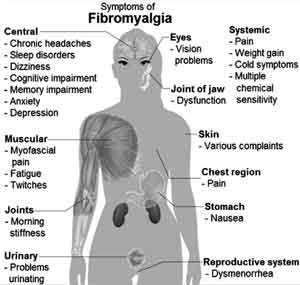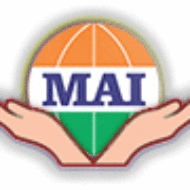by Dr. Kiran Adam
Generalised Soft Tissue Rheumatism (STR) or Fibromyalgia (FM) is characterised by increase pain perception experience by person out of proportion to the painful stimulus. This disease commonly seen in women 10 times more than men, approximate age group in females is from 26 to 60 yrs.
People with certain Rheumatic diseases such as RA, SLE can have associated STR too. This condition is not restricted in its involvement to soft tissues but has a systemic effect. Present article attends to this aspect.
- Neurological System (NS) – According to statistics 48% of the people may have depression & 65% may have headache. Some people face Issues Related to NS such as disturbed sleep, cognitive dysfunction such as forgetfulness & inability to concentrate, memory or thought problems.
- Heart – Few patient rush to Emergency Department for their severe Chest Pain with palpitation sweating and breathlessness, Many tests are performed on patients, but we get surprised as results of all reports are normal. STR is the likely case at work. As discussed earlier it is due to magnification of simple stimulus. Everyone is scared of these (Heart) diseases and hence it is always there in their MIND! Once report is normal and serious heart disease is ruled out the way ahead is tackling this STR effect.
- Lungs – Some patients may have breathing complaints such as breathlessness, dyspnea, shortness of breath. A careful clinical evaluation is necessary.
- Abdomen – Related to stomach or digestive system, IBS (Irritable Bowel Syndrome) is most common among all the other symptoms in STR. People suffering from IBS face problems such as abdominal pain, bloating discomfort, loose motion, constipation or alternating occurance of these symptoms. Incomplete evaluation (Incomplete bowel movements) etc is seen. Studies have proved that upto 60% face IBS in STR.
- Urinary system – Common feature is irritable bladder syndrome
People having this issue suffer through nocturia, urgency and sometimes leakage. They have sleepless nights and they frequently have to go to urinate. - Gynaecological System – Dysmenorrhoea is very common, patient may have severe pain during or by few days before menstrual period. It can be severe enough making patient incapable. They can also suffer pain in pelvis, inner thigh and back.
- Sexually disorder – People with STR may suffer sexual dysfunction. This aspect remains in closed doors and many times un-discussed. Both sexes can get affected. A lady may have low libido, frigidity, vaginal discomfory while a male can have low libido, erectile dysfunction or premature ejaculation. If these problems are given due consideration most of them could be solved.
- Other systems or pain – In STR there are few common pain such as hearing difficulties, vision problem (Blurred), oral ulcers, rash, fever, weight gain, hair loss, hypersensitivity to cold.
- Fatigue – Though not a specific organ dysfunction it still needs specific mention Fatigue is one the most prevalent features of STR. It is observed that 76% to 81% peoples of STR suffer trough fatigue. Symptoms such as flu like malaise (weakness loss of energy) sore throat or common. Patient gets exhausted with routine activity thereby reducing working capacity. Most of the examination performed on patients of STR comes out to be normal. This makes matter even worse.
- Exercise difficulty – Most patients of STR, tense their muscles during exercise This reduces blow flow to the muscle when causes pain. Suggestions for dealing with increased pain or fatigue with exercise can be given to overcome this problem. There is evidence that moderate exercise may improve sleep mood, pain, energy balance cognition and psychologic well being in multiple population. Aerobic Intervention have included cycling, jogging, walking (land and treadmill) aerobic dancing. Most recently aerobic heated pool exercise, stretching or strengthening exercises have evolved and their utility in STR is being established
Recognise the importance of rest or a time for sleep.
For chronic headache use lower volume setting for music, avoid flash lights. OJECTIVE sleep apnea or restless leg syndrome which are common in STR generally face sleep problems (difficulty in falling asleep, difficulty in staying asleep or non refreshing sleep) A combination of medication regime generally improves sleep quality fatigue and ability to exercise. It is beneficial to refer to sleep management.
People with STR are experiencing a sleep vise in obesity. Such a person faces additional challenges trying to maintain the exercise and can feel self consciousness about in participating in group classes. A professional help will sincerely help tackle this scenario. Role of Walking is well supported in literature. Walking promotes core strength and may reduce back pain. Start with small steps on even ground to minimise exercise related pain. If exercising is at home, consider walking around the block several times, rather than walking a mile away from house. Low impact aerobic exercise walking in a warm water pool may be an excellent strong point which reduces pain. Aerobic exercise increases cardiovascular fitness and reduces pain.
Rheumatologist, Physiotherapist, Occupational therapist social workers, psychologist, as a team are excellent resources in helping patients learn to balance rest and exercise. With joint partnership of these therapist an exercise program can be laid by
teaching patient how to avoid stretching and strengthening muscle groups.
Cognitive Behavioural Therapy such as bio feedback and relaxation measures may also help STR patient to improve their condition and exercise capacity.
Impact on general health quality of life – An adverse effect on both physical and emotional aspect adversely affect the quality of life of patient with STR. Approximately 50% of all patients have difficulties with routine daily activities while 30% to 40% have to stop work or change their career. The lack of support from family, friends healthcare systems may further compound problems.
Education – As STR is a chronic condition patient education is an important aspect of management. It needs to be understood that efforts are directed to minimise pain increase efficiency but not complete resolution of pain.
With a methodical and participative approach it can be ensured that patients of fibromyalgia lead a happy and productive life
Summarising the non-pharmacological management for STR.
- Patent education
- Graded exercises
- Heat water therapy with or without exercises
- Cognitive behavioural therapy
- Relaxation
- Rehabilitation
- Physiotherapy
- Physiological support

